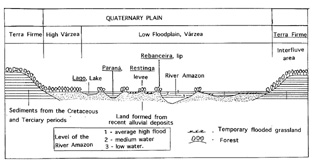

The climatic changes are fluctuations that radically transform the height of the river Amazon, and are associated with the increase in rainfall over the whole basin. In the general location the Lower Middle Amazon the river level has roughly an eight metre height variation from wet to dry season. Given that the floodplain of the Lower Middle Amazon is estimated to be about fifty kilometres wide (Meggers 1971: 28), this is a massive increase in water. These changes are of such a central observable feature of floodplain life, it is impossible to avoid them, since what is land, lake and river in the dry season becomes, in the wet season, one vast mass of water, with houses acting as little islands, and the trees half drowned by the muddy waters. People are faced with a constantly transforming landscape.
As a result of the annual flooding, there are no fixed boundaries between differently recognised spatial domains which would demark the separation of the land, forest, house, garden, lake and stream. Such landmarks and spaces are in a constant process of definition and becoming. The forest is not just a place for wild animals, but also a place where the fish go in the wet season to eat fruits, berries and nuts. Thus, the forest has two local names, igapó in the wet season meaning the flooded forest, and matá, or just forest, in the dry season. In the local view, the water creates the land and imparts power to it during the flood. Thus, the land and water are inseparable from each other in the local perception of the landscape and their bonding is an integral part of `land' use. As one person told me in an extended discussion of the ambiguity of the floodplain, este rio é nossa terra, this river is our land.
The river's edge then is not a boundary between land and water, or wild and domesticated spaces. On the contrary the river's movements express neatly the vagueness of boundaries between wild and domesticated spaces on the floodplain. It is important to note that these areas of the floodplain, while critical to floodplain existence and the reproduction of local communities, are not valorised in monetary terms. The floodplain itself officially belongs to the Navy (Marinha) according to Brazilian law.
The importance of the Amazon river has long been recognised as a central factor in people's lives in the Amazon. The variation of the Amazon River has been characterised with reference to its rhythmical qualities, and the annual cycle of flooding and lowering of the Amazon river has been likened to a `mighty heartbeat' of a pulsating river (Sternberg 1975: 26 and see Sternberg 1954 for an excellent discussion of várzea geography). Another author goes so far as to claim the river commands life, o rio comanda a vida (Tocantins 1968). He concludes that there is a mystical union between people and the river in the Amazon region (Tocantins 1968: 306).
The variation in the height of the River Amazon at the Port of Óbidos, with measurements taken between 1992 and 1994.
